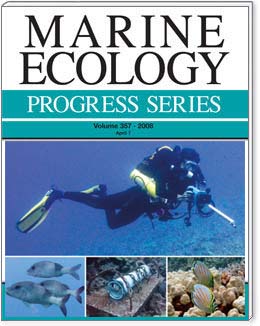Marine Ecology - Progress Series Q1 Unclaimed
Marine Ecology Progress Series (MEPS) was founded in 1979, and Its original concept was based on a comprehensive, integrated treatise on life in oceans and coastal waters. MEPS serves as a worldwide forum for all aspects of marine ecology, fundamental and applied. The journal covers: microbiology, botany, zoology, ecosystem research, biological oceanography, ecological aspects of fisheries and aquaculture, pollution, environmental protection, conservation, resource management. It has an SJR impact factor of 0,804.
Marine Ecology - Progress Series focuses its scope in these topics and keywords: sea, north, breeding, fish, reef, distribution, food, importance, species, affect, ...
Type: Journal
Type of Copyright:
Languages: English
Open Access Policy:
Type of publications:
Publication frecuency: -


3150 €
Inmediate OANPD
Embargoed OA0 €
Non OAMetrics
0,804
SJR Impact factor223
H Index318
Total Docs (Last Year)770
Total Docs (3 years)26927
Total Refs1905
Total Cites (3 years)770
Citable Docs (3 years)2.25
Cites/Doc (2 years)84.68
Ref/DocOther journals with similar parameters
Nature Sustainability Q1
Fungal Diversity Q1
Genome Biology Q1
Human Reproduction Update Q1
Annual Review of Ecology, Evolution, and Systematics Q1
Compare this journals
Aims and Scope
Best articles by citations
Population differentiation in the barnacle Chthamalus malayensis: postglacial colonization and recent connectivity across the Pacific and Indian Oceans
View moreArctic kelp eco-physiology during the polar night in the face of global warming: a crucial role for laminarin
View moreStable isotopes reveal inter-annual and inter-individual variation in the diet of female Australian fur seals
View moreShort-term processing of ice algal- and phytoplankton-derived carbon by Arctic benthic communities revealed through isotope labelling experiments
View moreOn the trophic coupling between protists and copepods in arctic marine ecosystems
View moreIce scour disturbance to benthic communities in the Canadian High Arctic
View moreSea wrack delivery and accumulation on islands: factors that mediate marine nutrient permeability
View morePolychaete species diversity in the central Pacific abyss: local and regional patterns, and relationships with productivity
View moreSpatial patterns of aerobic and anaerobic mineralization rates and oxygen penetration dynamics in coral reef sediments
View moreKrill-copepod interactions at South Georgia, Antarctica, II. Euphausia superba as a major control on copepod abundance
View moreRecent seawater temperature histories, status, and predictions for Madagascar's coral reefs
View moreComparative feeding of three species of larval fishes in the Northern Gulf of Mexico: Brevoortia patronus, Leiostomus xanthurus, and Micropogonias undulates
View morePopulation dynamics of coastal forests of Macrocystis pyrifera in Puerto Toro, Isla Navarino, Southern Chile
View moreVariations in primary production of northern Gulf of Mexico continental shelf waters linked to nutrient inputs from the Mississippi River
View moreSpecies-specific decomposition rates of beach-cast wrack in Barkley Sound, British Columbia, Canada
View morePlankton community properties determined by nutrients and size-selective feeding
View moreBioenergetic characterization in Aurelia aurita (Cnidaria: Scyphozoa) polyps and application to natural polyp populations
View morePlankton community structure and role of Oithona similis on the western coast of Greenland during the winter-spring transition
View moreVertical distribution of exopolymer particles in sea ice of the Fram Strait (Arctic) during autumn
View moreOcean observatory data are useful for regional habitat modeling of species with different vertical habitat preferences
View moreMeasuring predation with tethering experiments
View moreBleaching of an intertidal coralline alga: untangling the effects of light, temperature, and desiccation
View moreSeabird diet changes in northern Hudson Bay, 1981-2013, reflect the availability of schooling prey
View morePivotal role of sea ice sediments in the seasonal development of near-shore Arctic fast ice biota
View more
Comments